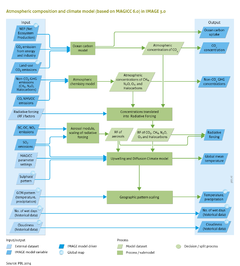Atmospheric composition and climate/Description: Difference between revisions
Jump to navigation
Jump to search
Oostenrijr (talk | contribs) m (Text replace - "N2O" to "N<sub>2</sub>O") |
Oostenrijr (talk | contribs) m (Text replace - "NOx" to "NO<sub>x</sub>") |
||
| Line 4: | Line 4: | ||
The IMAGE climate model (based on [[MAGICC model|MAGICC 6.0]], [[Meinshausen et al., 2011a]]) calculates atmospheric CO<sub>2</sub> concentration based on CO<sub>2</sub> emission data for energy, industry and land-use change (Component[[Emissions]]); terrestrial carbon balance (Component [[Carbon cycle and natural vegetation]]); and carbon uptake by the oceans (calculated in MAGICC on the basis of the Bern Ocean Carbon model). | The IMAGE climate model (based on [[MAGICC model|MAGICC 6.0]], [[Meinshausen et al., 2011a]]) calculates atmospheric CO<sub>2</sub> concentration based on CO<sub>2</sub> emission data for energy, industry and land-use change (Component[[Emissions]]); terrestrial carbon balance (Component [[Carbon cycle and natural vegetation]]); and carbon uptake by the oceans (calculated in MAGICC on the basis of the Bern Ocean Carbon model). | ||
Concentrations of other long-lived greenhouse gases (CH<sub>4</sub>, N<sub>2</sub>O, and halocarbons), and tropospheric ozone (O3) precursors (CO, NMVOC) are calculated by MAGICC in a simple atmospheric chemistry module. Halocarbons and N<sub>2</sub>O concentrations mostly show a simple mass-concentration conversion and half-life behaviour. CH<sub>4</sub> and ozone dynamics are more complex, with CH<sub>4</sub> lifetime depending on the OH concentration level, and O3 and OH concentration levels depending on CH<sub>4</sub> concentrations, and | Concentrations of other long-lived greenhouse gases (CH<sub>4</sub>, N<sub>2</sub>O, and halocarbons), and tropospheric ozone (O3) precursors (CO, NMVOC) are calculated by MAGICC in a simple atmospheric chemistry module. Halocarbons and N<sub>2</sub>O concentrations mostly show a simple mass-concentration conversion and half-life behaviour. CH<sub>4</sub> and ozone dynamics are more complex, with CH<sub>4</sub> lifetime depending on the OH concentration level, and O3 and OH concentration levels depending on CH<sub>4</sub> concentrations, and NO<sub>x</sub>, CO and NMVOC emissions ([[Meinshausen et al., 2011b]]). | ||
===Atmospheric energy balance=== | ===Atmospheric energy balance=== | ||
Change in atmospheric gas concentrations also changes the amount of radiation absorbed or transmitted by the atmosphere, and thus changes the earth’s energy balance and temperature. The energy balance change is expressed as radiative forcing per gas, measured in W/m2. In MAGICC, concentrations of long-lived greenhouse gases are translated into radiative forcing values using radiative efficiency estimates from the IPCC ([[Myhre et al., 2013]]), and radiative forcing of tropospheric ozone is calculated based on ozone sensitivity factors from MAGICC6.0 ([[Meinshausen et al., 2011a]]; [[Meinshausen et al., 2011b]]). | Change in atmospheric gas concentrations also changes the amount of radiation absorbed or transmitted by the atmosphere, and thus changes the earth’s energy balance and temperature. The energy balance change is expressed as radiative forcing per gas, measured in W/m2. In MAGICC, concentrations of long-lived greenhouse gases are translated into radiative forcing values using radiative efficiency estimates from the IPCC ([[Myhre et al., 2013]]), and radiative forcing of tropospheric ozone is calculated based on ozone sensitivity factors from MAGICC6.0 ([[Meinshausen et al., 2011a]]; [[Meinshausen et al., 2011b]]). | ||
However, other processes also lead to changes in the atmospheric energy balance, which are also modelled and assigned a radiative forcing value. Aerosols, such as SO<sub>2</sub>, | However, other processes also lead to changes in the atmospheric energy balance, which are also modelled and assigned a radiative forcing value. Aerosols, such as SO<sub>2</sub>, NO<sub>x</sub>, and organic carbon, have a direct cooling effect by reflecting more radiation back into space (direct aerosol effect). They also interact with clouds and precipitation in many ways (indirect aerosol effect); this cloud feedback is the largest source of uncertainty in estimating climate sensitivity ([[Denman et al., 2007]]). Although also an aerosol, black carbon has a strong direct warming effect ([[WMO/UNEP, 2013]]). | ||
Direct and the indirect aerosol effects are approximated in MAGICC by scaling the radiative forcing in a reference year (mostly 2005) with the relative increase in future emissions with respect to emissions in the reference year. As MAGICC assumes radiative forcing by albedo and mineral dust to stay constant over the scenario period ([[Meinshausen et al., 2011a]]), this is also assumed in IMAGE. | Direct and the indirect aerosol effects are approximated in MAGICC by scaling the radiative forcing in a reference year (mostly 2005) with the relative increase in future emissions with respect to emissions in the reference year. As MAGICC assumes radiative forcing by albedo and mineral dust to stay constant over the scenario period ([[Meinshausen et al., 2011a]]), this is also assumed in IMAGE. | ||
Revision as of 10:38, 1 July 2014
Parts of Atmospheric composition and climate/Description
| Component is implemented in: |
|
| Related IMAGE components |
| Projects/Applications |
| Models/Databases |
| Key publications |
| References |
